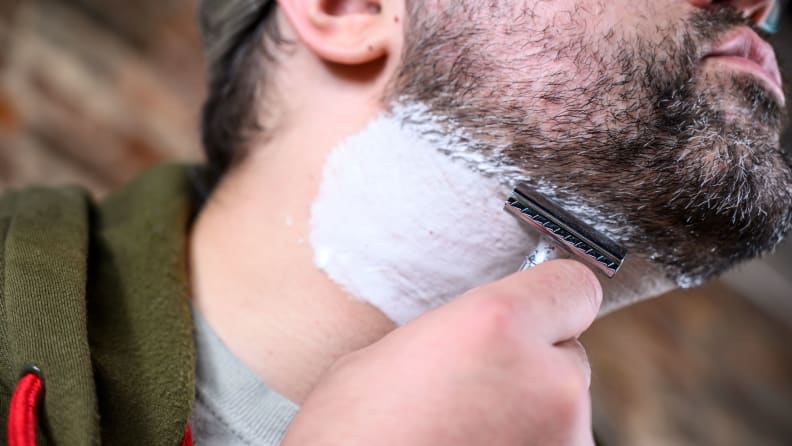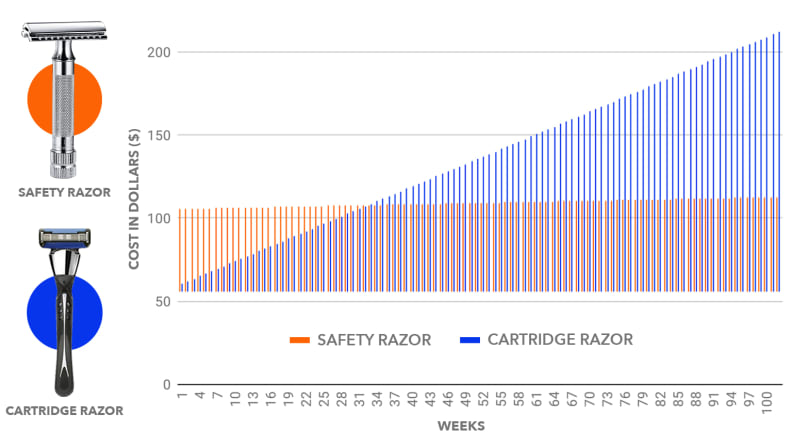If you're not using this razor, you're doing it wrong
Everyone who shaves should use a safety razor
Products are chosen independently by our editors. Purchases made through our links may earn us a commission.
To some degree or another, shaving is a part of life for many people. Whether it’s your face, head, legs, armpits or elsewhere, safety razors are almost always better than cartridge-based shavers. But if you’re not used to safety razors, they can be intimidating. Despite their dangerous appearance, however, they can often offer a safer, closer, cheaper shave than their cartridge-based counterparts.
I started using safety razors 10 years ago and have never looked back—and neither has anyone who I’ve convinced to give it a shot.
A closer shave
Have you ever shaved with a cartridge-based, multi-bladed razor and found some areas were shaved smooth, but other areas still had stubble? Between the plastic housing and multiple blades, a cartridge razor creates many different points of contact with your face. It can be difficult to know you’re maintaining an even balance and pressure just by feel alone. Many cartridge razors attempt to mitigate this with pivoting heads, which may help, but they still can give users less direct control over where the razors are hitting and with how much pressure—which can result in those stubbly patches.
Picture sitting on a stool with four legs of slightly different lengths. You would likely balance on three of the legs while one hovers slightly above the ground. That’s similar to what can happen while shaving with a multi-bladed cartridge: One part is hovering slightly above where it should be, which doesn’t make for a close shave.
Safety razors take out a lot of that guesswork. The only point of contact with your skin is the edge of the blade, so it’s very easy to develop a feel of what will actually get cut.
More precise lines

Safety razors are great for shaving a clean, straight edge along a patch of hair.
Safety razors also allow for more precise shaving. Cartridge-based blades have anywhere between two and seven blades (yes, seven) and wrap their razors in plastic buffers. Have you ever tried to shave a clean line with a multi-bladed cartridge? Not only do the lubrication strips obfuscate where first razor actually starts, it’s really easy to overshoot and wind up with a small notch in an otherwise neatly groomed line.
It’s certainly doable, but it can feel like the “before” scenario in a commercial that’s about to show you a better way. Since safety razors have just a single razor that sticks out, it’s easier to both see and feel where you’re about to shave. It’s very easy to gently line up the blade exactly where you want it to be, resulting in smoother, straighter, and more consistent lines.
Less skin irritation
One of the clearest ways in which safety razors show their superiority is regarding razor burn, the persistent irritation caused by shaving. According to many different sources and lots of personal experience, this irritation can be exacerbated by several factors, including shaving the same area repeatedly, shaving with a blunt blade, shaving too close or with too much pressure, or shaving with an unclean blade.
It’s easy to see why the design of a multi-bladed razor cartridge might make some of these problems worse. For starters, multiple blades means a single stroke drags multiple razors across the same area by default. Having to re-shave an area only exacerbates the problem.
Determining if your blade is dull can also be more difficult with a cartridge. The wear between the blades likely won’t be even, and it can be hard to tell one of the blades is a little dull when the other one can still cut. This can result in raking your face with one dull razor and one sharp one, or misjudging the appropriate pressure, leading to nicks, cuts, and razor burn.
This is also related to the issue of pressure—don’t apply enough and you’ll still have stubble and need to shave over the area again. Press too much and you’ll get more irritation.
Significantly lower costs over time

Even if your personal purchasing numbers are slightly different, the overall trend remains the same: Cartridge razors are cheaper for the first year or so, after which point they become significantly more expensive.
This is a fairly easy point to make. Based on our in-house research and personal shopping experience, a decent price for a single, good-quality cartridge is less than $2. If you’re looking at razors specifically marketed for women, your options will run an additional 50 cents.
From personal experience, a traditional double-edged razor lasts about as long as a cartridge. You can buy a package of 100 razors online for under $7. We crunched the numbers a few times on this one, and it seems like a significantly less expensive alternative.
Some downsides of safety razors
While there are a lot of reasons to like safety razors, there are some downsides too. Here are three of the biggest drawbacks.
Double-edged razor blades are absolutely terrifying
It’s true! Razors blades are incredibly sharp, and safety razors can make it easier to cut yourself compared to cartridges. Judging from an informal poll of our office, the most common feedback about double-edged razor blades was that they looked “scary” or “painful.”
The truth is, feeling nervous is not only natural, it’s actually a great place to start: It means you understand you’re dealing with a very sharp implement and are more likely to take appropriate caution as you get used to your new shave. If you’re starting out overconfident, chances are you’ll pretty quickly cut yourself back down to size. It’s best to go slowly and let the weight of the razor add the pressure for you. You’ll quickly get used to the feel.
Honestly, once you get over the initial squeamishness and feel more confident in your shaving, you’ll start to understand how safety razors actually feel a lot less scary to use than cartridge-based razors. You have so much more control over your shave with a safety razor. There’s no uncertainty or guesswork: You feel exactly where the razor is and it shaves exactly where it feels like it’s shaving. It’s a more precise tool, like switching from a paint roller to a brush.
Additionally, safety razors often have more adjustability options than cartridge-based razors. Safety razors like the MERKUR Progress (available at Amazon for $68.40) are a great option for beginners because you can adjust how guarded you want to blade to be. Feeling nervous, or shaving around more delicate areas? Turn the knob and the handle will bend the razor, angling it downward, shrinking the area between the metal safety guard and the blade. This reduces the risk you might accidentally nick yourself. Feeling braver, or shaving tougher-skinned areas? Turn the knob the other way and the blade will become more flat, allowing you to get a very close shave with fewer strokes.
I’ve had my MERKUR Progress since 2010 and beyond the few minutes of initial uncertainty it’s been smooth shaving.
There’s a higher startup cost
As illustrated earlier, safety razors do cost more money up front. Cartridge-based razor handles cost about $5 for just the handle, while a decent safety razor runs in the $30- to $50-range. Again, though, if you’re able to stomach the start-up cost, you’ll likely start saving money within a year.
You can only fly with double-edged razors in a checked bag
While it might not affect most people, this one can be a bummer for frequent fliers, especially since I never check my bags unless absolutely necessary. It can sometimes be a pain to locate new razor blades.
Recycling your razors
Regardless of which razor you prefer, disposing of the blades requires some forethought. Once you’ve used your razor blade, you can’t just throw it away; it’s a sharp piece of metal whose sole function is to cut. It’s dangerous, for you and for others, to have random sharp bits of metal hidden, unsecured, out in the world.
The best way to get rid of razors is to recycle them. Unfortunately, the rules about how to do this are different depending on your area. Some areas allow you to drop razors off in the metals bin at the local recycling center, provided they’re stored in a recyclable metal box (Rockwell Razors makes a good, inexpensive option). Your area might also have other options available, such as a pharmacy’s sharps recycling program.
If your municipality doesn’t allow razor recycling of any kind, some companies sell cheap, disposable razor boxes, like Feather and Bro Shaver. You could even tape up an Altoids tin if you happen to have one handy.
For any un-converted cartridge-shavers still reading, Gillette and Terracycle recently launched a new razor recycling program in select areas as well.
The verdict
Despite a handful of downsides, safety razors offer a smooth, precise, and inexpensive shave—once you get past any initial jitters. If you’re looking to try out a safety razor, the MERKUR Progress is a good place to start. It’s sturdy and offers a customization knob to help dial down the chance you might accidentally nick yourself. Others in our office have vouched for the
If you’re looking for a lower-cost entry-point, others in our office have vouched for the Edwin Jagger DE89, which is currently available for under $28.
You’ll also need a set of razors to start with: We’ve had good personal experience with Astra blades.
Still not convinced? We recently reviewed cartridge razors and can say your best option is most likely the Gillette Mach3 Turbo.
